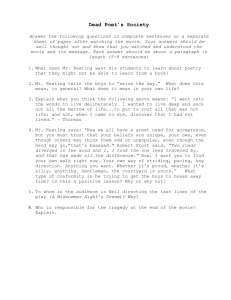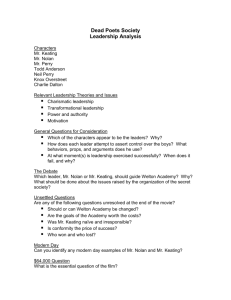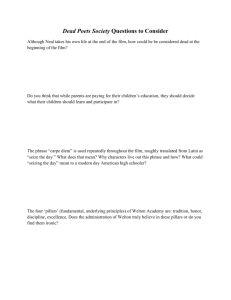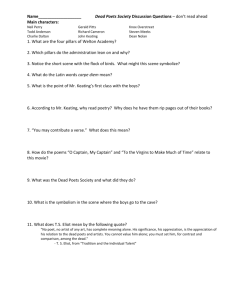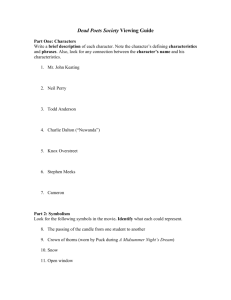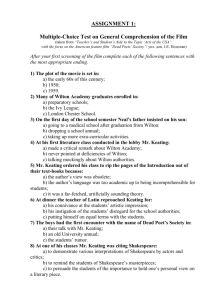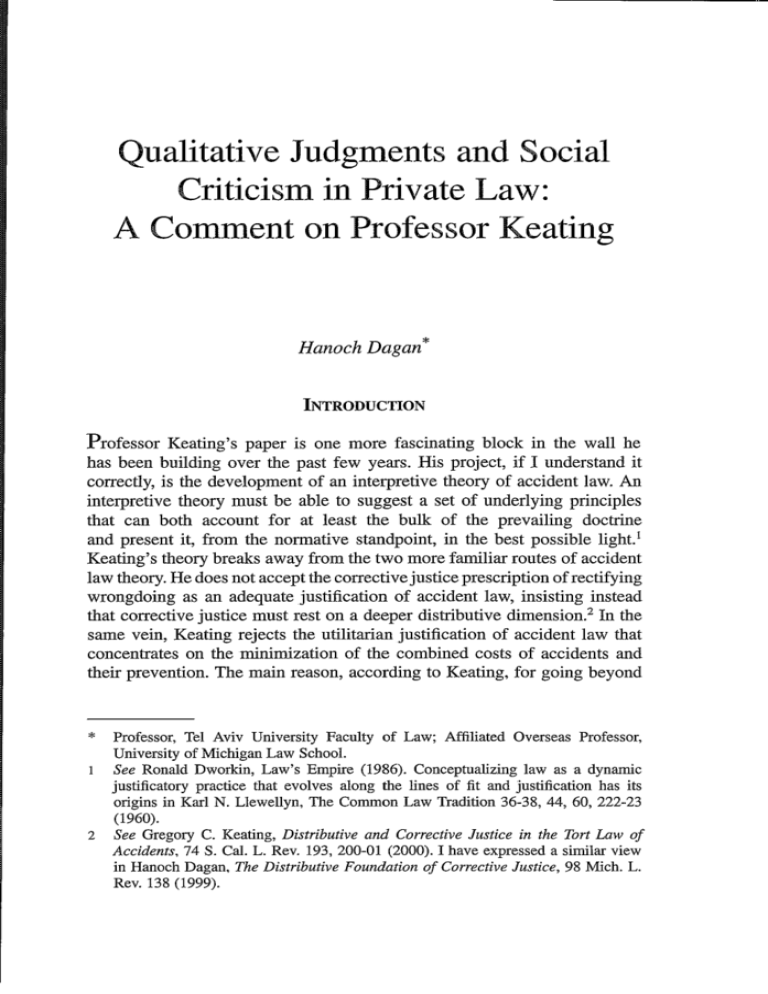
Qualitative Judgments and Social
Criticism in Private Law:
A Comment on Professor Keating
Hanoch Dagan*
INTRODUCTION
Professor Keating's paper is one more fascinating block in the wall he
has been building over the past few years. His project, if I understand it
correctly, is the development of an interpretive theory of accident law. An
interpretive theory must be able to suggest a set of underlying principles
that can both account for at least the bulk of the prevailing doctrine
and present it, from the normative standpoint, in the best possible light.'
Keating's theory breaks away from the two more familiar routes of accident
law theory. He does not accept the corrective justice prescription of rectifying
wrongdoing as an adequate justification of accident law, insisting instead
that corrective justice must rest on a deeper distributive dimension. 2 In the
same vein, Keating rejects the utilitarian justification of accident law that
concentrates on the minimization of the combined costs of accidents and
their prevention. The main reason, according to Keating, for going beyond
Professor, Tel Aviv University Faculty of Law; Affiliated Overseas Professor,
University of Michigan Law School.
I See Ronald Dworkin, Law's Empire (1986). Conceptualizing law as a dynamic
justificatory practice that evolves along the lines of fit and justification has its
origins in Karl N. Llewellyn, The Common Law Tradition 36-38, 44, 60, 222-23
(1960).
*
2
See Gregory C. Keating, Distributive and Corrective Justice in the Tort Law of
Accidents, 74 S. Cal. L. Rev. 193, 200-01 (2000). I have expressed a similar view
in Hanoch Dagan, The Distributive Foundation of Corrective Justice, 98 Mich. L.
Rev. 138 (1999).
Theoretical Inquiries in Law
90
[Vol. 4:89
the utilitarian goal of cost-justified precaution is that the utilitarian calculus
"aggregates incommensurable benefits and burdens across persons," thus
failing "'to take seriously the distinction between persons."" Keating's
theory of accident law in general and his article in this Volume in particular
seek to avoid the utilitarian trap by focusing on the way accident law distributes
costs and benefits. His distributive analysis of accident law is, more precisely,
a celebration of Rawlsian fairness: Accident law, explains Keating, should
"reconcile liberty and security on terms that are both favorable and fair.
Favorable terms enable people to pursue their aims and aspirations over the
course of complete lives; fair terms reconcile the competing claims of liberty
and security in ways that benefit even those they disadvantage." 4 It is with
this underlying conception of justice as fairness that we should approach his
current article.
I.
PROFESSOR KEATING'S MAIN PROPOSITIONS
Keating's background assumption is that the utilitarian cost-benefit analysis
is acceptable when the interests at stake are commensurable. 5 But this
conventional approach of "public" theories of accident law should not apply,
in his view, with respect to risks of "devastating injury, injury that is severe
and irreparable," risks that can "ripen into death and incurable disease." 6
Regarding such risks of severe and permanent injuries, he maintains, it is
appropriate for accident law7 to "press precaution beyond the point of costjustification,"8 because "[n]o number of trivial gains can ever compare to a
single one of the devastating injuries that are their price. The gains and the
losses are simply not comparable, morally speaking."9 Furthermore, Keating
rejects in this context the familiar law and economics division of labor
argument of maximizing wealth and then redistributing it fairly: "Because
3
Gregory C. Keating, IrreparableInjury and ExtraordinaryPrecaution:The Safety
and Feasibility Nonns in American Accident Law, 4 Theoretical Inquiries L. 1, 13
(2003) (citing John Rawls, A Theory of Justice 24 (rev. ed. 1999)).
Gregory C. Keating, Fairness and Two Fundamental Questions in the Tort Law of
Accidents 4-5 (U.S.C. Olin Working Paper No. 99-21, Jan. 2000).
5 Keating, supra note 3, at 9-10.
6 Id. at 8, 13.
7 Keating focuses on non-tort accident law. But, as Keating himself notes, id. at
2-4, there is no reason to limit the normative prescriptions he advocates to these
administrative alternatives to tort law.
8 Id. at 6.
4
9
Id. at 43.
QualitativeJudgments and Social Criticism
2003]
91
devastating risks are not fully compensable, the actual gains of those who win
cannot be used to repair the harm done to those who lose." 10
Keating notes that
[t]he fairness rationale is ... [that] it is (presumptively) unfair to
devastate a few for the sake of gains that are not comparable, morally
speaking, to the hardship wreaked by death and devastating injury, no
matter how many others may reap those gains and even if the total
quantity of "benefit" as measured by cost-benefit analysis exceeds the
total "cost" of the devastation that is its price.'"
Thus, "[r]educing risks of devastating injury beyond the point of maximal
benefit (economically conceived) is justified when the gains to be won are not
morally comparable to the death or devastation that is their price. ""2 More
particularly, Keating endorses the legislative safety-based and feasibilitybased standards as the proper standards for these risks:
Reducing risks of devastating injury to the point where they are
"insignificant" - the demand of safety-based regulation - is justified
when the benefits of bearing a "significant" risk of devastating injury
are not comparable, morally speaking, to the burdens. Reducing risks
of devastating injury as far as we feasibly can without crippling the
beneficial activity that generates the risks - the demand of feasibility
analysis - is justified when crippling the activity in question would
work a harm comparable to bearing a significant risk of devastating
injury.' 3
An important part of Keating's effort is devoted to explaining why
his main claim regarding the incommensurability of
-notwithstanding
devastating injuries and trivial benefits - accident law is still justified in
protecting only against "significant" risks, and, in certain contexts, only
insofar as such protection is "feasible."'4
The "significance" requirement, he maintains, derives from "[t]he fact
that a low level of risk of devastating injury - the background level of
lo Id. at 20.
1i Id. at 24-25.
12 Id. at 12.
13 Id.
14 As an aside, one should not underplay the difficulties of the legislative strategy of
non-verifiable sanction-backed aspirational commands. See James A. Henderson, Jr.
& Richard N. Pearson, Implementing Federal Environmental Policies: The Limits
of Aspirational Commands, 78 Colum. L. Rev. 1429 (1978).
92
TheoreticalInquiries in Law
[Vol. 4:89
risk - is an inescapable price of activity ... and activity is worth having."J15
Thus, it may be justified in some cases to impose
risks of devastating injury ... even though each instance of their
imposition realizes only trivial benefit, because there is no plausible
way of distinguishing among instances of the risk imposition ...
and the burden of eliminating all instances of such risk imposition
is comparable to the significant risk of devastating injury that the
practice creates.' 6
Once we realize that "the elimination of all discernible risk requires
the elimination of all discernible activity,"' 7 the "significance" requirement
becomes necessary to "distinguish the realm of irreducible, or unavoidable,
risk from the realm of avoidable risk":` 8
"Significance" separates those risks whose elimination is desirable
from those whose elimination is not. If a particular risk really is
significant, then that risk is different from a number of other risks,
and the distributed cost of eliminating that risk is not the cost of
eliminating a host of indistinguishable risks."9
"Significant" risks of severe and irreparable injury should be eliminated rather than merely "internalized" as economic efficiency prescribes - "when
the costs of doing so are not comparable to the devastation that significant
risks are sure to wreak."20 The reason for this stringent standard, explains
15
16
17
Keating, supra note 3, at 42.
Id. at 44-45.
Id. at 50.
18 Id.
19 Id. As Keating insists,
[t]he fairness of insisting that some precaution be taken depends not so much on
the cost of taking that precaution in the case at hand as it does on the cost of
taking that precaution in the class of cases to which it applies. Practices of risk
imposition, not individual instances of risk imposition, are the law's basic unit
of analysis.
Id. at 47. Therefore,
[i]f it is impossible to distinguish among a substantial number of very small
risks of grave harm, each of which might be eliminated by a precaution whose
cost is very small, and if the aggregate cost to each prospective injurer of taking
all these precautions is unacceptably high, then it is rational not take any of the
precautions, even though each of them, viewed individually, appears justified.
Id. at 49.
20
Id. at 51.
QualitativeJudgments and Social Criticism
2003]
93
Keating, is that "health has a special urgency":2 1 because health is "something
that each person needs in order to realize her aims and aspirations over the
course of a normal lifespan,"2 2 it "takes priority over lesser goods, inessential
goods." 2 3 Health should never be sacrificed for these lesser goods; health is
not commensurable with productivity, and thus health and productivity should
not be balanced, whatever the level of excess productivity may be.24
Tradeoffs begin only "[w]hen the burden of bearing the precaution
necessary to reduce a 'significant' risk of devastating injury (and all
indistinguishable risks) to the point of 'insignificance' is of a kind that
might outweigh the burden of devastating injury that is the price of the
risk." 2 5 Keating acknowledges that judgments of comparability are intuitive,
but they "reflect a general idea": 2 6
Harms are comparable when their impact on the lives of those they
affect is similarly grave - when they impair ordinary activities,
or important activities, or the pursuit of rational life plans, in
similarly severe ways. Harms are comparable when they strike at
the preconditions of rational agency in similarly severe (or similarly
mild) ways. 2 7
So there are cases where health is justifiably sacrificed: activities that "are
sufficiently valuable that shutting them down would work greater hardship
than allowing them to continue." 2 8 In such cases, instead of requiring the
elimination of all significant risks, it is justified to apply the more attenuated
standard of feasibility that allows "a 'significant' level of risk - when our
only alternative is to shut down a valuable activity. "29 These significant but
unavoidable risks are bearable because the risky activity is "sufficiently
valuable that shutting the activity down would work a greater hardship to
those who benefit from it than would asking those workers endangered by the
activity to bear significant risks of devastating injury." 3 0 Because "the value
21
22
23
24
25
26
27
28
29
30
Id. at 60.
Id.
Id.
Id. at 60-61.
Id. at 62.
Id. at 10.
Id.
Id. at 63.
Id. at 63-64.
Id. at 63.
94
Theoretical Inquiries in Law
[Vol. 4:89
of the activity is greater than the devastation that is its price," bearing the risk
is more justified than shutting down the activity.3"
The regulatory framework Keating examines embodies a judgment
respecting the comparability of "significant risks of devastating injury [and]
the termination of economically productive, but everyday, activities." 3 2
Keating acknowledges that this judgment may be controversial, but still
goes on to defend its application by the law because these activities are
"deeply entrenched in our social world" so that "[e]nding them abruptly
would cause massive, unpredictable dislocation." 3 3 The enormous influence
of such socially "contingent" facts regarding the value of certain activities
does not undermine the law's integrity, insists Keating. Thus, in discussing
the feasibility standard, Keating concedes that "the importance of various
activities whose elimination would eliminate significant risks of devastating
injuries ... depends on contingent facts."3 4 But he insists that because "our
need for activities that are socially contingent and historically transitory" is
"as deep as our need for bodily integrity," we still should not "take the risk
of shutting down a significantly risky activity lightly" unless "an equivalent
range of values can be realized by [a] set of activities that do not create a
significant risk of devastating injury. ""
II.
INCOMIMENSURABILITIES AND QUALITATIVE JUDGMENTS
Keating's theory is not merely a critique of, and an attractive alternative to,
cost-benefit analysis. It also resists the even broader convention of balancing
competing interests, which is - at least since Roscoe Pound's seminal
contribution 3 6- the predominant way of addressing legal questions. Keating
insists that the incommensurability of health and productivity generates a
lexical priority between these two distinct types of goods. 37 This lexical
priority requires the elimination of risks of severe and irreparable physical
injury, without any consideration of possible competing interests. Only the
existence of comparable harm - in the form of elimination of all discernible
activity or the crippling of a sufficiently socially valuable activity, one that
31
32
33
34
35
36
37
Id. at 65.
Id.
Id. at 67.
Id. at 76.
Id.
Roscoe Pound. A Survey of Social Interests, 37 Harv. L. Rev. 1 (1943).
On lexical priority, see Rawls, supra note 3, at 42-44.
20031
QualitativeJudgments and Social Criticism
95
is essential to personal liberty - can justify the relaxation of this imperative
and the introduction of the provisos of "significance" and "feasibility."
Keating may be interpreted as confronting head-on Guido Calabresi's
insistence that legal discourse suppresses the uncomfortable idea that life
does have a price, that law regularly compromises the lives of a significant
number of people in order to preserve and facilitate the leading of a good
life for the rest of us.3 8 But this is not the only way to understand Keating's
approach. An alternative interpretation - the one I find more appealing is as a proposal for the introduction of some qualitative distinctions among
values and interests, with no particular stance vis-a-vis the myth of the sanctity
of life.
Read along the lines of the first interpretation, Keating's analysis seems
to me dubious, at times even apologetic. It is unconvincing to maintain
that accident law does not sanction tradeoffs on life and health because, in
Keating's words,
[llosing a job (the consequence to those most severely affected of
shutting down some ordinary economic activity) does not appear
comparable to losing life or limb or to suffering a health impairment
that will permanently and severely impair normal functioning and
shorten the span of one's life - typical consequences of serious
occupational diseases. 3 9
Furthermore, if the normative ideal of accident law is the sanctity of life and
health, arguing that, because "ongoing, productive activities, which flourish
in a market economy, ... have passed the market's test of value," they are
"something of significant value to many people" 4 0 appears to be an exercise
in apology. If the idea is that our commitment to life and health is beyond any
gain to be gamered in terms of leading a good life, then law's compromises
appear to be sheer sham, cloaking the harsh reality of the unjustified immunity
granted to capitalist activities. If this is the case, then the contention that most
legal norms are just as hypocritical as the "safety" and "feasibility" standards
only adds insult to injury.4"
38 Guido Calabresi, Ideals, Beliefs, Attitudes, and the Law: Private Law Perspectives
on a Public Law Problem 1, 5 (1985).
39 Keating, supra note 3, at 66.
40 Id.
41 This is so because this claim merely highlights the success of law as an instrument
for denial and apology. In other words, it vindicates the CLS claim that law restricts
our imagination to the prevailing arrangements in society and thus artificially secures
the prevailing structures of power, hegemony, and subordination; that law mystifies
social life, encouraging people to think that the practices codified in law have fixed
96
Theoretical Inquiries in Law
[Vol. 4:89
But I believe that a more charitable reading of Keating is possible.
Rather than vindicating the sanctity of life and health and the banality
of productivity, Keating can (and I believe should) be read as calling for
qualitative analysis in accident law. What is important to appreciate, under
such an interpretation of his article, is not the inviolability of life and limb,
but, rather, that the values and interests accident law must consider are
irreducible to some ultimate, single value. Insisting that some valueslife and health as well as the daily activities that define our social reality
or some subset thereof - should be viewed as incommensurably greater
than marginal outputs does not require the denial of tradeoffs between
health and productivity. Rather, it entails a social deliberation that identifies
and validates the interests and activities that are, for the given community,
intrinsic objects of value and that brings about a resolution of conflicts
between divergent interests and activities according to the community's
hierarchy of values.4 2
The viability of this interpretation of Keating's theory, as a call for
qualitative judgments in private law, can be demonstrated by looking at the
qualitative distinctions among different types of resources that pervade
current law. A conspicuous example is the rules governing monetary
recovery following the appropriation of different types of resources: land and
chattels; copyright, trademark, and patent; trade secrets, contractual relations
and performances, and pre-contractual expectations; individual reputation
and frozen what they can hope to achieve, thus de-politicizing contingent choices
and immunizing the prevailing ideology and the existing power structure from any
political critic. See, e.g., Robert Gordon, New Developments in Legal Theory, in
The Politics of Law: A Progressive Critique 413 (David Kairys ed., rev. ed. 1990).
42 See Richard H. Pildes, Conceptions of Value in Legal Thought, 90 Mich. L. Rev. 1520,
1557 (1992). Pildes advances his claim in the context of constitutional adjudication,
which, he maintains, should not be understood as a quantitative process, but rather
as a qualitative one: Government can infringe on rights for reasons consistent with
the norms that characterize the common goods that those rights are meant to realize,
but when government infringes rights for reasons inconsistent with these common
goods, it violates individual rights. Impermissible justifications are not subject to
an all-things-considered balancing test; rather, they simply make government action
unconstitutional.
Parenthetically, I may add that Pound's most recent biographer, Edward McLean,
maintains that even Pound - a propagator of balancing - did not reduce social
choice to purely mechanical calculation. Rather, as McLean reads Pound, weighing
the competing interests should proceed on the basis of applying the rich and complex
values of "a civilized society." This is, McLean explains, an intentionally non-neutral
term, referring to a specific - liberal - social vision. Edward B. McLean, Law
and Civilization: The Legal Thought of Roscoe Pound at xvi, 219-20 (1992).
2003]
QualitativeJudgments and Social Criticism
97
and dignity, commercial attributes of personality, and even identity and
physical integrity.4 3 Not all cases of appropriation of these resources lead
to the same measure of recovery; different measures of recovery apply to
different resources. Thus, there are resources with respect to which the mere
appropriation triggers a rather severe measure of recovery that allows the
resource holder to choose between the fair market value of the resource or its
unauthorized use and the net profit gained by the appropriator. In American
law, this is the case in respect of appropriations that are invasions of the
resource holder's identity, physical integrity, or land. However, there are
resources whose invasion triggers pecuniary recovery only if the appropriator
employed improper means. Thus, the mere appropriation of trade secrets or
pre-contractual expectations triggers no liability. Between these two poles
we find several other interesting points along the spectrum. In the case
of appropriation of copyright, the resource holder can choose between the
fair market value of the copyright at issue and a proportional part of the
appropriator's profits. With the appropriation of patents, however, the resource
holder is entitled to only recovery of fair market value.
This diversity of measures of recovery with respect to the appropriation
of different resources makes no sense in terms of cost-benefit analysis. But
it is by no means chaotic or unprincipled. Rather, the diversity reflects
the differing degrees to which society perceives those certain resources as
constitutive of their possessors' identities. Thus, the more closely a resource
is regarded as attached to its possessor's identity by her society, the greater
the degree of protection accorded to that resource, and vice versa.
The legal choices among the different pecuniary measures available to the
injured party - from mere compensation for the harm suffered, to various
intermediate measures such as fair market value of the resource (or its use),
to profits garnered by the appropriator at the resource holder's expense
embody a choice between competing values. The profits measure of
recovery implies that transfers can be made legitimate only by obtaining
the plaintiff's ex ante consent. By deterring nonconsensual invasions, the
profits remedy vindicates the cherished libertarian value of control. The
remedy of fair market value, in contrast, does not deter appropriations
indeed, at times, it may even encourage them. Fair market value as a
remedy secures the (objective) level of well-being that is embodied in the
appropriated resource, thus vindicating the utilitarian value of well-being.
43 The discussion in the rest of this Part derives from my previous work on the law of
restitution, Hanoch Dagan, Unjust Enrichment: A Study of Private Law and Public
Values (1997).
98
Theoretical Inquiries in Law
[Vol. 4:89
Finally, recovery limited to compensation for the harm suffered serves
the appropriator's claim to a share of the resource holder's entitlement
so long as the former does not actually diminish the latter's estate. Thus,
the harm-based measure of recovery vindicates the value of sharing; it is
a form of limited institutionalized altruism, a legal device that calls for
other-regarding action and seeks to instill other-regarding motives.
The qualitative distinctions between the various resources people hold
mirror (and arguably also shape) the intrinsic significance of those resources:
the degree to which they are perceived as constitutive of their holders'
identities. The law vigorously vindicates people's control regarding their
most precious, constitutive resources: their identities, physical integrity,
reputations (as dignity), and land. Interests invested with a lesser degree
of personhood - copyright and (to a smaller degree) the commercial
attributes of one's personality and patents - are less protected. Finally,
the mere appropriation of resources from the third group (which includes
the least personal resources - contractual relations and performances and
information) does not trigger liability unless the invasion was conducted
by improper means. It is mostly with regard to resources that are relatively
remote from the crux of selfhood that a prescription of sharing applies.
Law's qualitative judgments become more complex in cases where the
active participant in the legal drama, the defendant, did not appropriate
the plaintiff's resource, but, rather, harmed that resource while engaging
in a valuable human activity. In such cases, the law cannot focus merely
on the significance of the plaintiff's resource, namely, life and limb in the
cases Keating considers. Rather, it must take into account the significance
of the defendant's activity as well. In cases of valuable activities that may
be crippled by a stringent precaution requirement, tradeoffs are warranted.
Such tradeoffs should be (and are) based, as Keating insists, on qualitative
judgments of the intrinsic value of the plaintiff's resource and of the
defendant's activity or, more precisely, on judgments of the significance of
the type of resource and of the type of activity at stake.
m.
SOCIAL VALUES AND SOCIAL CRITICISM
Qualitative judgments of the relative intrinsic value of resources and
activities are frequently premised on socially contingent facts. Keating's
discussion accepts and justifies this feature of the law. One premise of his
2003]
QualitativeJudgments and Social Criticism
99
defense is the distinctive feature of a legal regime that accepts "so much of
our existing social world."44
Insofar as resorting to socially contingent facts is legitimate, it must
45
be justified from the standpoint of political morality. In this respect, the
comments that follow may reinforce Keating's defense of the importance of
socially contingent facts to private law determinations. But this support has
a price. Only some socially contingent facts, not all, may, upon reflection,
turn out to be morally acceptable and therefore deserving of an elevated role
relative to their morally unacceptable counterparts. Regarding the latter type
of facts, the law should not defer to our contingent reality. Instead, in order to
preserve its integrity, the law must respond to, rather than shy away from, its
latent (and potentially radical) ideals.
In Keating's analysis, privileged activities are those activities that are so
"deeply entrenched in our social world" that their "abrupt" disappearance
4 6 Similarly, the
would work "inconceivable disruption in our lives."
privileged resources in the discussion of remedies above are perceived of
as constitutive: resources to which people, here and now, are attached because
these resources are understood by those people and their society as reflecting
their holders' identities. Inboth cases, the social meaning of the activity or the
resource in question - which is local rather than universal, contingent rather
than necessary - determines its relative value. How can these social values
be sanctioned as a matter of political morality? How can we distinguish
between "good" and "bad" social values?
I believe that political morality can sanction the contingent values that we
as a society ascribe to certain resources and activities, even if these values
are contingent in the sense that it would have been morally acceptable
for us to have different values. No relativism, skepticism, or nihilism is
involved in this proposition. Value pluralists, who convincingly reject the
meta-ethical positions of the relativist, the skeptic, and the nihilist, still
insist that some significant degree of cross-cultural variability is morally
acceptable. Following Isaiah Berlin, value pluralists maintain that human
life is replete with competing values that cannot be reconciled, as well as
with legitimate wishes that cannot be truly satisfied. Because some values
intrinsically conflict and because we cannot have everything we want,
we must make choices. "The need to choose, to sacrifice some ultimate
44
45
46
Keating, supra note 3, at 75.
Keating does not seem to dispute this point. Id. at 74-77.
Id. at 67.
100
TheoreticalInquiries in Law
[Vol. 4:89
values to others, turns out to be a permanent characteristic of the human
predicament." 4 7
Many of the claims to resources and activities require private law to make
such difficult accommodations. Every society is called upon to pick and
choose certain resources and certain activities as more valuable, and given
value pluralism, there is no single "right" choice. Frequently, the contingent
social meanings of resources and activities will themselves determine the
resources in which people invest their personalities 4 8 and the activities they
perceive as indispensable to their lives.
The contingency of privileged resources and activities does not necessarily
undermine their moral significance. 4 9 The practice of personality-reflection in
resources is morally valuable because external identifications andregistrations
of the self in (socially contingent) resources impose consistency, permanence,
and stability upon people's resolutions, plans, and projects; this practice
requires responsibility, self-discipline, and maturity and thus fosters people's
moral development. 5 0 Likewise, many valuable socially contingent human
activities in our world - that are absent from, or insignificant in, other social
environments in other places and other eras - provide us with invaluable
channels through which we are able to express ourselves or with means that
expand our options and allow us to achieve objectives we would otherwise
be unable to achieve. Because these resources and activities are justifiably
valuable, the law is justifiably deferential to these socially contingent facts.
But by no means does it follow that the law must blindly accept the
contingent content of our social world - either in general or in legal
discourse. Theories like Keating's should lead us to constantly reexamine
our (too often implicit, even subconscious) assumptions of the relative value
47
48
49
Isaiah Berlin, Introduction, in Four Essays on Liberty at 1-li (1969).
Usually there is no reason to think that subjective valuations will be particularly
idiosyncratic: Resources gain their significance as reflections of the self socially.
People perceive certain resources as greater reflections of their personalities than
other resources are and thus attach to these resources subjective value, because other
people in society - to whom the external image of the self is communicated-share
with them the same symbolic understanding. Therefore, not only considerations of
rule of law, but also the nature of the phenomenon of constitutive property itself
justify law's reference to social (objective) meanings.
But see Stephen J. Schnably, PropertyandPragmatism:A Critiqueof Radin s Theory
of Property and Personhood, 45 Stan. L. Rev. 347 (1993) (claiming that relying on,
and inculcating, existing understandings create or compound social problems).
50
See Jeremy Waldron, The Right to Private Property 353, 364-65, 369-70, 372-73,
378, 385 (1988). See also Peter G. Stillman, Property, Freedom, and Individuality
in Hegel's and Marx r Political Thought, 22 NOMOS 130, 135 (1980).
2003]
QualitativeJudgments and Social Criticism
101
of resources and activities. His theory is potentially subversive because it
helps us realize that in order to validate our current practices, we need
to justify the relative value we attribute to resources and activities. The
requirement of justification is always potentially challenging to some of our
conventional opinions because it requires at least a respectable universalistic
fagade, an idealized picture, that can be - and often is - a fertile source
of social criticism, for it sets standards that our current practices do not
necessarily live up to. The idealism of our social world, even if it is a
hypocritical idealism, is the best source of any critical engagement. 5 1
Take, for example, our understanding of land as constitutive property
and the resultant significance we attach to land ownership. Traditionally,
land has been one of the most prominent objects of property rights in
Western culture, accorded a unique status as a symbol of the self and
as a resource closely linked to personal freedom, rank, and power. 5 2 This
social value invites a certain degree of refinement: the distinction between
"personal land" (like the family home or farm) and "fungible land" (used
solely for commercial purposes). If some of the legal privileges accorded
to landowners are justified by reference to the nature of land as property of
a constitutive nature, as they frequently are, then arguably these privileges
should be limited to personal land only. 53 More generally, if land (or some
other resource) is important to the individual because only through owning
51
See Michael Walzer, Interpretation and Social Criticism 22, 30, 41, 43, 46-48, 61
(1987). See also Margaret Jane Radin, Lacking a Transformative Social Theory:
A Response, 45 Stan. L. Rev. 409 (1993). (We should not always and everywhere
act on our knowledge that everything is unstable and dependent upon everything
else. Some contexts must remain intact in order for others to be transcended.
Some conceptions must be taken for granted in order for others to be challenged.
Deconstruction is therefore not necessarily a good idea, though at times it is.)
52 See Donald W. Large, This Land Is Whose Land? Changing Concepts of Land as
Property, 1973 Wis. L. Rev. 1039, 1040; Clare Cooper, The House as Symbol of
the Self in Environmental Psychology: People and Their Physical Settings 435,
437-38 (Harold M. Proshansky et al. eds., 2d ed. 1976); Herbert McClosky & John
Zaller, The American Ethos: Public Attitudes toward Capitalism and Democracy
138 (1984); Lynton K. Caldwell, Land and the Law: Problems in Legal Philosophy,
1986 U. Ill. L. Rev. 319, 320; Margaret J. Radin, Propertyand Personhood, 34 Stan.
L. Rev. 957, 992, 1013 (1982); Russell W. Belk, Possessions and the Extended Self,
15 J. Consumer Res. 139, 153 (1988); E. Doyle MaCarthy, Toward a Sociology of
the Physical World: George Herbert Mead on Physical Objects, 5 Stud. Symbolic
Interaction 105, 116-17 (1984).
53
Some clues to such a distinction can be found in Hawkes Estate v. Silver
Campsites, [1994] 7 W.W.R. 709, 721 (B.C.); Centex Homes Corp. v. Boag, 820
A.2d 194 (Sup. Ct. N.J. 1974). See also Margaret J. Radin, Reinterpreting Property
12 (1993) (the strongest justification for according control over resources - the
102
TheoreticalInquiries in Law
[Vol. 4:89
and controlling property can she confer on her will a stability and maturity
that would otherwise not be possible- if absent some constitutive ownership,
people's moral development is seriously at risk-property (thatis, potentially
constitutive property) must be available to all.5 4
A similar analysis should apply regarding activities. In discussing
the heightened risks associated with motorcycles, Keating notes that
these risks are "inseparable from the characteristics [that] define the
activity of motorcycling [and] give it its distinctive value as a form
of recreation and mode of transportation." 5 5 Because our current practices
sanction motorcyclists' "sensual thrill of experiencing high-speed travel," 56
any precaution that "transforms the activity of motorcycling" by "killing the
joy of [this] activity" is deemed "infeasible." 5 7 I assume, along with Keating,
that this deference to current social practices respecting motorcycling is
justified given what we know of the risks and the benefits of this activity.
But should the same deference apply with respect to the activity of smoking?
Should the value of smoking be determined solely according to people's
current preferences? I think not.5 8 It seems to me that in considering, for
example, prohibitions on smoking in public or anti-smoking advertisement,
we must take into account the epidemiological studies that now show, even
to the satisfaction of the tobacco manufacturers, that smoking tobacco is
a major cause of devastating illnesses, including cancer, heart disease, and
emphysema. 5 9
The lesson of this example is that conceptualizing the "feasibility" standard
as a test that implies that an activity is qualitatively privileged, so that a
risk of its elimination justifies risking life or limb, requires us to scrutinize
the activities that we currently privilege, to reexamine their status given
the risks they generate as well as their potential contribution to human
flourishing. And reaffirming prevailing attitudes toward motorcycling does
not automatically confirm social attitudes toward smoking. In other words,
activities are indistinguishable only if both the risks they generate and their
54
55
56
57
58
justification from personhood - does not apply to the vast majority of proprietary
interests and certainly does not apply to the typical resources of modem-day
capitalism).
See Waldron, supra note 50, at 377-78, 385-86, 429, 444.
Keating, supra note 3, at 70.
Id. at 56.
Id. at 70.
Keating agrees, id. at 57-59.
59 See Hanoch Dagan & James J. White, Governments, Citizens, and Injurious
Industries, 75 N.YU. L. Rev. 354, 358-59 (2000).
2003]
QualitativeJudgments and Social Criticism
103
potential contribution to human flourishing are indistinguishable. Therefore,
pace Keating, the mere fact that many things are likely to inspire children to
play with fire does not necessarily make toy lighters in gumball machines
indistinguishable from matches, lighters, gas stoves, outdoor grills, television
shows, or dry conditions at the end of a hot summer. 6 0
Indeed, like most helpful positive theories, Keating's theory of non-tort
accident law provides not only an explanatory account of the law as
we know it. As with most positive theories, we should not expect his
theory to explain every feature of the law. The blemishes of theories, like
Keating's, that seek to unveil law's justificatory premises, namely, the
gaps between existing doctrinal rules and normative justifications, may
well be the most important output of such theories, because they provide
an opportunity to rethink those cases in which the law does not live up to
its own implicit ideals.6 ' In such cases, positive theories of law, including
Keating' s analysis of non-tort accident law, must discard their explanatory
role in favor of critique.
CONCLUSION
In his article in this Volume. Keating presents a persuasive justification for
the standards set by the administrative alternatives to tort liability that go
beyond cost-justified precautions. Rather than as advocating the myth of
the sanctity of life, I suggest to read his theory as a subtle celebration of
qualitative distinctions among activities according to the risks they generate
as well as their potential contribution to human flourishing. Under this
reading, Keating's analysis of the value law attributes to activities people
engage in coheres with the value attributed by private law to the various
resources people hold.
In judging the values of both activities and resources, the law accords
significant importance to prevailing social understandings. In many, maybe
most, cases, this is not an embarrassing feature that requires tormented
excusing. Rather, this local, cultural dimension of law is unobjectionable
given value pluralism. But this is not always the case. An articulation of
60
61
Keating, supra note 3, at 48. Cf Calabresi, supra note 38, at 5 (noting that fireworks
are prohibited and automobiles not, even though fireworks kill far fewer people than
automobiles do).
See Ronald Dworkin, Taking Rights Seriously 118-23 (1977) (noting the inevitability
of developing some theory of institutional mistakes within even an ideal theory of
law).
104
Theoretical Inquiries in Law
[Vol. 4:89
the qualitative distinctions that law makes among resources and activities
is, or at least should be, also an invitation for critical reassessment of the
justifications underlying our current legal practices.
COPYRIGHT INFORMATION
TITLE: Qualitative Judgments and Social Criticism in Private
Law: A Comment on Professor Keating
SOURCE: Theor Inq Law 4 no1 Ja 2003
WN: 0300108750003
The magazine publisher is the copyright holder of this article and it
is reproduced with permission. Further reproduction of this article in
violation of the copyright is prohibited.
Copyright 1982-2004 The H.W. Wilson Company.
All rights reserved.

